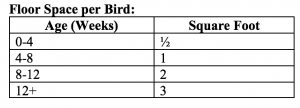BABY CHICK CARE & FEED
BABY CHICK CARE
WATER: The majority of baby chick fatality is because the chick does not start to drink right away. Water is more important than feed on the first day. Never let them run out of water. For the first 24 hours, add 1 tablespoon of molasses/gallon of water (sugar water). On the 2nd day add vitamins-electrolytes to water. One gallon waterer is adequate for 50 chicks. Even if its self-filling there MUST be 1 waterer per 50 birds to prevent overcrowding. If you choose to use apple cider vinegar, it is very important not to use more than 1 teaspoon per quart of water and do not use a metal waterer with it as the acid will corrode the metal causing it to leach into the water.
*Ducks may swim in water after 4 weeks. Attempt to keep them dry until then.
FEED:
*One-foot minimum feeder/waterer space per 25 chicks to prevent over-crowding.
Chicks: Purina program
0-18 weeks: Flockraiser 20% until harvesting or until 18 weeks for layers. Flockraiser is available with medication or without medication. If using medicated, we recommend that it is used for the first 2-3 weeks. Chicks need to be taken off medicated feed within 2 weeks of harvesting.
After 18 weeks: Layena
Broiler Chicks: Prince program
0-4 weeks: Prince Broiler Starter 25% Non med.
4 weeks to finish: Broiler Finisher 20% Non med.
Layer Chicks: Prince program
0-10 weeks: Prince Chick Starter 20%
10-18 weeks: Prince Pullet Grower 17%
18 weeks-life: Prince Layer
Organic Broiler Chick Program
0-5 weeks: 21% Organic Chick Starter/Grower
5 weeks–finish: 19% Organic Chick Starter
Organic Layer Chick Program
0-5 weeks: 19% Organic Chick Starter
5-18 weeks: 16% Organic Chick Grower
18 weeks: Organic Layer
Turkeys: Prince program
0-8 weeks: 28% Turkey Starter (med or nonmed)
8 – life: 18% All Flock mini pellet
Ducks or Geese: Purina program
0-18 weeks: Flockraiser non-medicated
18 weeks – life: Duck grower or Layena
Pheasant or Quail:
0-6 weeks: 28% Prince Turkey Starter (non-med)
6 weeks-life: 24% Prince Gamebird Grower or Purina non medicated 20% Flockraiser
Guineas:
0-6 weeks: 28% Prince Turkey Starter (med or non-med)
6 weeks-life: 24% Prince Gamebird Grower or Purina non medicated 20% Flockraiser
HEAT: Use a heat lamp in a draft-free area. Place heat lamp approximately 20” above chicks. Baby chicks need a temperature of 95 degrees. Please use a thermometer to be sure you have them at the correct temperature. You will lose chicks if they are too hot or too cold. If they huddle together, they are too cold. If they huddle in corners, they are too hot. Reduce 5 degrees each week to a minimum of 65 degrees.
BEDDING: Straw or Large Flake wood shavings are the best choice for chickens and turkeys. Allow approximately ½ square foot per chick, and 1 ½ square feet per adult. Straw is the best choice for ducks and geese.
Space Requirements for the Home Flock
*A 10’ X 10’ brooder house is adequate until 8 weeks of age.



